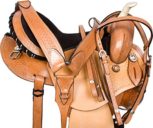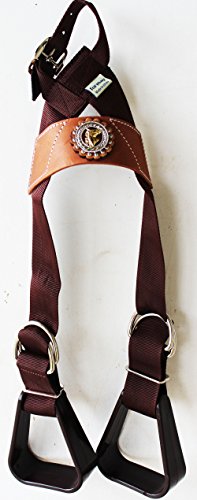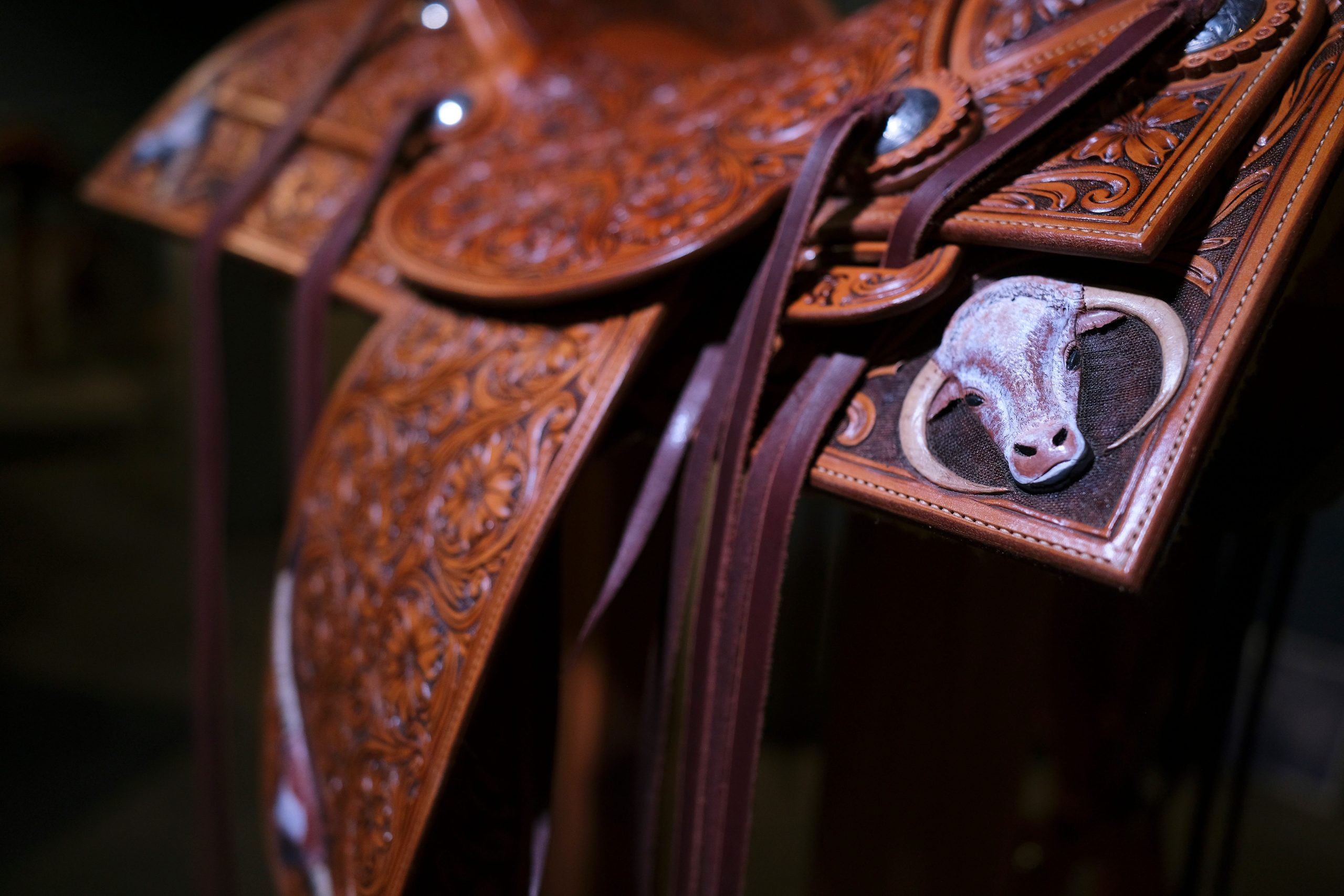[ad_1]
Show Caption
Hide Caption
Traditional Cowboy Arts Association creates high-quality tack
The Traditional Cowboy Arts Association Exhibition and Sale is on display at the National Cowboy and Western Heritage Museum until January 2, 2022.
Addison Kliewer, Oklahoman
For nearly four decades, Jay Adcock has been transforming strips of cowhide into the tools of his ranching trade.
Nowadays, he’s still making reatas and reins, hobbles and quirts, but he’s turning gear traditionally used to work horses into intricate works of art ready for a collector’s case.
“I grew up in a ranching family, and I worked on ranches my whole life. … Whatever ranch I was working for or managing, I always braided a little rawhide on the side for some supplemental income,” he said. “I was managing a ranch up until three years ago, and I was so far behind and had so many orders with my rawhide stuff that I just went to work for myself.
“I thought I’d spend a winter getting caught up, and I just keep getting further behind.”
As a new member of the Traditional Cowboy Arts Association, the Pawhuska rawhide braider is rounding up a thrilling achievement: Having his functional artworks exhibited at a museum.
Four of Adcock’s intricately braided pieces — a half-scale bridle set; a reata, or braided rawhide rope; a quirt, which is a short whip used to steer a horse; and a set of hobbles, which are used to keep a horse tethered in place — are included in the 22nd annual Traditional Cowboy Arts Exhibition & Sale at the National Cowboy & Western Heritage Museum.
“Just becoming a member, it was very satisfying. I was really proud of that, and then to be able the first year to make stuff that they’re showing at The Cowboy … I was on cloud nine,” Adcock said.
Organization preserves and elevates Western traditions
Continuing through Jan. 2, the Traditional Cowboy Arts Exhibition & Sale showcases saddles, bits and spurs, braided rawhide tack and Western silver pieces created by top artisans from the United States, Canada and Argentina.
“It is an event that is almost magical. These are things that are considered utilitarian, yet when you see them, they are just so gorgeous and so beautiful that they transcend their utilitarian purpose and become art. And this is a perfect place for that meeting of utilitarian goods and art,” said National Cowboy Museum President and CEO Natalie Shirley.
Founded in 1998 at the museum, the Traditional Cowboy Arts Association is a collective of saddle makers, bit and spur makers, rawhide braiders and silversmiths working to preserve traditional Western crafts and elevate them into fine art forms.
“Traditionally, craftsmen like to keep their secrets, (and) didn’t do a lot of sharing, particularly in the Western field. … The idea of sharing your techniques and your secrets to making your best possible saddle or bit, it was revolutionary at the time. So, being able to pass on those traditions instead of having them die … is a big deal for this organization,” said Nathan Jones, the museum’s associate curator of history.
“Their goal is to make the most challenging piece, the most interesting piece, they’ve ever made every year. … None of them think they’ve peaked in their career yet, whether they’re 40-something or 80-something.”
Oklahoma artist started as a rancher
Adcock, 52, grew up in northeastern Oklahoma near Ramona, where his grandfather, Elwood Adcock, ran a ranch.
“He made a belt for everybody in the family — which he had 12 kids and 36 grandchildren — and he always did a lot of leather work in his spare time. And I pretty much grew up at his side,” Adcock said. “I had an uncle who braided some rawhide, and that just really intrigued me. … He braided really simple stuff — quirts and hackamores and hobbles and whatnot — nothing really elaborate or fancy, just serviceable.”
Adcock was still a teenager when Osage County cowboy Charlie Chambers helped him craft his first quirt.
“He showed me how to cut out a quirt out of rawhide with just a pocket knife, and it kind of started from there. I just kept trying to learn more,” Adcock recalled.
He even traveled as a teen to Lakeview, Oregon, where he stayed with and learned from longtime rawhide braider Frank Hansen.
After high school, Adcock took a feedlot job in California, where he was exposed to the work of the late, legendary rawhide braider Luis Ortega. About a year later, he moved to a big cattle outfit in Paisley, Oregon, which allowed him to learn again from Hansen.
Ranching took him to Nevada, Wyoming and Texas, where he studied ranch management at Texas Christian University in Fort Worth.
“I was a couple of years behind getting my obligations done in the rawhide world and just decided … I needed to work for myself instead of working for somebody else running a ranch,” Adcock said.
His role as a single dad to his daughter Ella, now 10, also motivated Adcock to become a full-time artist.
“It’s very satisfying: I make all my own rawhide, from skinning the cow to the finished product. And it still amazes me how it all works. Even after doing it 35 years, there’s still little things that I learn,” said Adcock, who also has a son, Hayden Adcock, 28, who lives in Butte, Montana, with his wife Britnee.
“Every once in a while, Ella will complain some. She might come home and I’ve got a piece of hide thrown in the bathtub that wasn’t quite wet enough for something. Then, I get in a little trouble, but it is really not gory or stinky.”
Cowboy artists merge form and function
Once he became a full-time rawhide braider — which involves cleaning, stretching and drying his hides and then cutting, plaiting and knotting the prepared rawhide into various equine tools — Adcock sought out coveted membership in the Traditional Cowboy Arts Association.
“This is a very small group of artisans. … They’re very, very careful and very particular about who can join in with them. The folks that come in need to be up to a certain standard of quality, so it does grow a bit slowly. But it is growing,” Shirley said. “What that means is that there’s a continuation, this isn’t an art that will die with a generation. This is an art that is living, and will continue on into the long future.”
Even as the members are striving to elevate their craft, form still meets function.
“Everything I make, it’s gonna work on a horse or function however it’s used … and then it’s a matter of maybe using finer strings or more color. Like a set of bridle reins, well, I make a lot of eight-strand reins to use day in, day out. But then say you’re going to make a plan on making a piece of art: You might braid a 16- or a 20-strands set of reins out of a lot finer strings that takes twice the time,” Adcock said. “I make a lot of quirts that are just totally functional, and a lot of people think they’re just beautiful. But they just look like a using quirt to me. That quirt in (the exhibit), I think the handle has close to 100 strands in it.”
And he plans to keep challenging himself to make his work even more intricate.
“If you ever reach the point where, ‘That’s perfect, I couldn’t have done it any better,’ well, you’re done. You’re not getting any better,” he said.
“Any fine craftsman, it doesn’t matter whether you’re silversmith or a saddle maker or you paint pictures, you’re never 100% satisfied.”
22nd annual Traditional Cowboy Arts Exhibition & Sale
When: Through Jan. 2.
Where: National Cowboy & Western Heritage Museum, 1700 NE 63.
Information: https://nationalcowboymuseum.org.
Adblock test (Why?)
[ad_2]
Source link








Comments
Comments are disabled for this post.